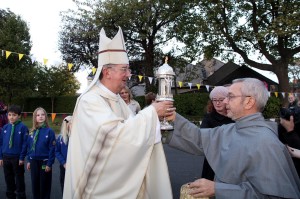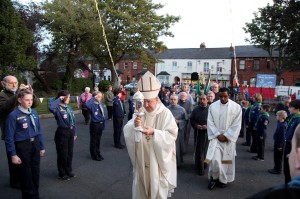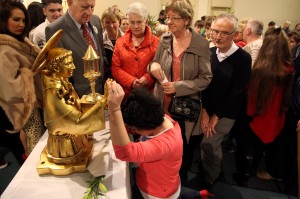
By Sarah Mac Donald - 18 October, 2013

Fr Mario Conte, OFM Conv, presents Archbishop Diarmuid Martin of Dublin with one of two relics of St Anthony of Padua at the opening of the visit of the relics to Ireland.
Photos: John McElroy
Archbishop Diarmuid Martin of Dublin has said the Church must learn a new path and not simply follow the culture of the day.
In his homily at the launch of the visit of the relics of St Anthony of Padua to Ireland, the Archbishop said the Church may be called to distance itself from aspects of that culture.
“This does not mean fleeing from reality into an unreal comfort zone. It may mean robustly rejecting some of contemporary culture’s tenets,” he said.
He added that it may also mean “robustly defending the Church’s rights” and working to influence that culture by witnessing to the power of Jesus’ message.
Addressing the packed Dublin Church in Fairview, the Archbishop noted that in the past, in an Ireland where demographically the vast majority of citizens were Christians, there was at times a false identification between faith and the culture of the day.
“Christianity and the Judeo-Christian tradition have truly helped to shape much of what is good in Irish society and has left an indelible mark of goodness. Sadly, when Church people deviated from the true message of Jesus lives were ruined,” the Archbishop observed.
He said that as contemporary Irish culture changes there is always the danger that even believers feel that the Church has to compromise on the authenticity of its teaching, to adapt its teaching to that change and change its teachings and its message.
 Elsewhere in his homily, he told the devotees of St Anthony gathered in the Church of the Visitation in Fairview that they were there to venerate “a great Saint.”
Elsewhere in his homily, he told the devotees of St Anthony gathered in the Church of the Visitation in Fairview that they were there to venerate “a great Saint.”
“We come full of trust in a Saint whose intercession has been invoked by men and women over centuries and in every corner of the world. This evening we turn to St Anthony of Padua with the intentions that are in the hearts of each of us and with the intentions of those who have asked us to pray for them. We do so with trust in the power of God which works through the intercession of this Saint.”
Explaining why they were honouring the relics of St Anthony, Archbishop Martin said the small piece of his skin “reminds us of Anthony the human person.”
“Sanctity is not something which is extraneous to our bodily lives. Holiness is attained not by a mysterious fight away from reality, but is worked out toil of mind and body by each of us, under the guidance of the spirit, in our bodies, in the real life situations in which we find ourselves, with our burdens, and our temptations. Holiness touches every part of our human fabric.”
Archbishop Martin was the chief concelebrant at this Mass along with the Papal Nuncio, Archbishop Charles Brown, and Fr Mario Conte, OFM Conv, Fr James McCurry, OFM Conv and Fr Antony Nallukunnel OFM Conv.
Padua-based Fr Conte is accompanying the relics – a small piece of bone from the Saint’s rib and a layer of St Anthony’s cheek skin – around six cities in Ireland.
The Franciscan friar said the relics of the Saint, who died in 1231, brought a message of hope to all those in Ireland badly affected by the recession.
 “St Anthony was a person who knew the difficulties people had economically. In Padua in the 13th century there was a lot of desperation. People were resorting to money lenders to survive.”
“St Anthony was a person who knew the difficulties people had economically. In Padua in the 13th century there was a lot of desperation. People were resorting to money lenders to survive.”
“Anthony was on the side of the poor. He was tough. He battled and challenged those who took advantage of the little people, especially the old people and women.”
He added that the visit of the relics was about bringing a message of hope to people that “God loves them and so they should not despair and that somehow providence will come to their aid.”
After Mass, hundreds of devotees, from the elderly to young boy scouts, waited in line to venerate the relic contained in a gold reliquary of the Saint, who is one of the most popular in the Catholic Church.
 The 2013 tour will see the relics visit Dublin, Wexford, Cork, Limerick, Galway and Belfast on 24 October before they cross to Britain.
The 2013 tour will see the relics visit Dublin, Wexford, Cork, Limerick, Galway and Belfast on 24 October before they cross to Britain.
More details: https://www.catholicireland.net/relics-st-anthony-ireland/